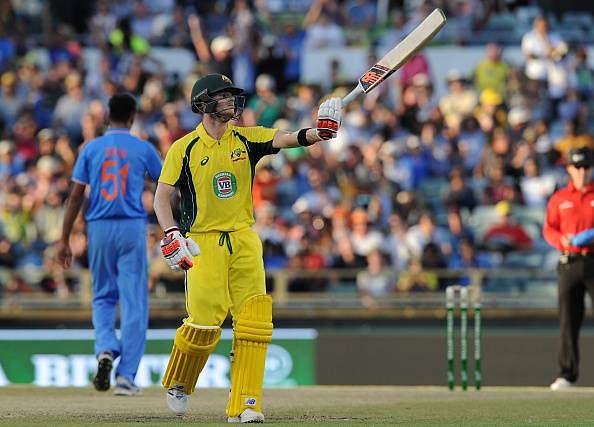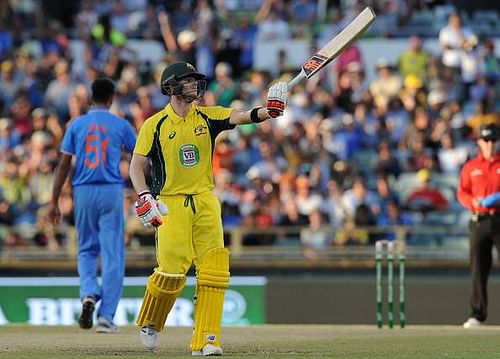
Why Australia are currently the best chasers in the 50-overs format?

After watching the opening encounter between India and Australia, it gave me glimpses of the Australia vs South Africa five-match series last year. The Proteas despite holding the upper-hand, more often than not, failed to see it off in the end.
Firstly, credit should deservedly go to India’s premier batsmen Rohit Sharma and Virat Kohli for their resurgent innings first-up, which were followed by even glorious innings of Steve Smith and George Bailey, who notched up their respective tons as well. At Perth, scoring a hundred from a visiting team, especially on the first game of the tour, takes remarkable quality, which Rohit Sharma certainly exemplified.
However coming back to India’s bowling, I would not say the bowlers had an off-day today, but today was perhaps another day where the Aussies showed their class and temperament while chasing a 300-plus run mark.
The scenario seems to be repetitive every time a strong team, like the Proteas, or even when India tours Down Under. Firstly, the Australian openers fail to notch up their game, while chasing, often handing the initiative to the visiting outfit. However, what is more interesting, though, is the middle order, whom most of us say is relatively cadet, after the top 3, is not. The last time around, the series was at 2-1, in favor of the Aussies (who batted first on all the three occasions) and the fourth encounter was in Melbourne.
Riding on a De Villiers 91, the Proteas took the score to 267 and left the Aussies pretty much in tatters at 98/5 with Maxwell departed. What followed was a resurgent response by Matthew Wade and Steven Smith, as they played out Robin Peterson, as comfortably as they played Ashwin and Jadeja, today. When Wade departed, Australia had crawled to 219, and with a James Faulkner cameo, they saw it off with one over to go. In the last encounter at Sydney, while chasing 280-odd, Australia again stuttered at the top with Warner out early yet Shane Watson and Steven Smith reinforced the situation, with James Faulkner again seeing it off. Australia, eventually emerged 4-1 victors.
Why is Australia so good in chasing on their home turf?
Though the easy answer to that would be home turf, which partially determines the quality of the run-chase. India certainly did that at home, chasing 350-plus scores with relative ease, yet those were on the back of the exceptional performances from the top 3, which hardly featured any middle-order batsmen. But for Australia, they have done this against the Proteas, who had the likes of Steyn and Morkel, and now against India, with their top 3 virtually failing on all these occasions.
The first answer to that would be Steven Smith’s admirable quality, temperament, and responsibility as a skipper. On every single of this run-chases, not only does he feature, but more importantly, plays an instrumental role in the outcome. It is not easy, even at home to spank three 100s, while chasing 260-plus scores or even 300-plus scores, with the top order back in the camp. Steven Smith has shown tremendous maturity, wherever he has played and in the opening game, he showed exactly why he is the best player in the game. With such a fidgety technique, many falls prey to the impression he is somewhat naive and lacks perfection in stroke-play; Smith, however, is just the opposite; ever since he has taken the captaincy he has taken plenty of onus upon himself and plays as a guiding torch throughout his innings. George Bailey is perhaps another similar component who reads the game exceptionally well. For Smith, his primary job especially while chasing is, perhaps, take the game deep which automatically turns it to your favor.
Next would perhaps be the stroke-play capability of Matthew Wade and Glen Maxwell, which keeps plenty of optimism in the camp, that they can chase any quantity of runs, if the situation demands, in the slog overs. Matthew Wade is also a calm-headed responsible cricketer who can knuckle down and provide ample assistance to his partner.
Jame Faulkner deserves a separate mention, for his true all-round skills; More than any other player in the middle order, James Faulkner has certainly been the best as a reader and slogger of the game, in the last two years or so. He is pretty much invaluable in his team. Faulkner readily accepts the job of seeing off the game, and he does that regularly. He is a proven finisher, besides who can forget his blistering 64 not out in Mohali, which saw Faulkner plunder 30 runs of a single Ishant Sharma over to seal India’s fate.
So unlike what we think, the Australian middle order perhaps get well together, blending a fine mix of composure and hitting prowess, which gives them an edge while chasing.